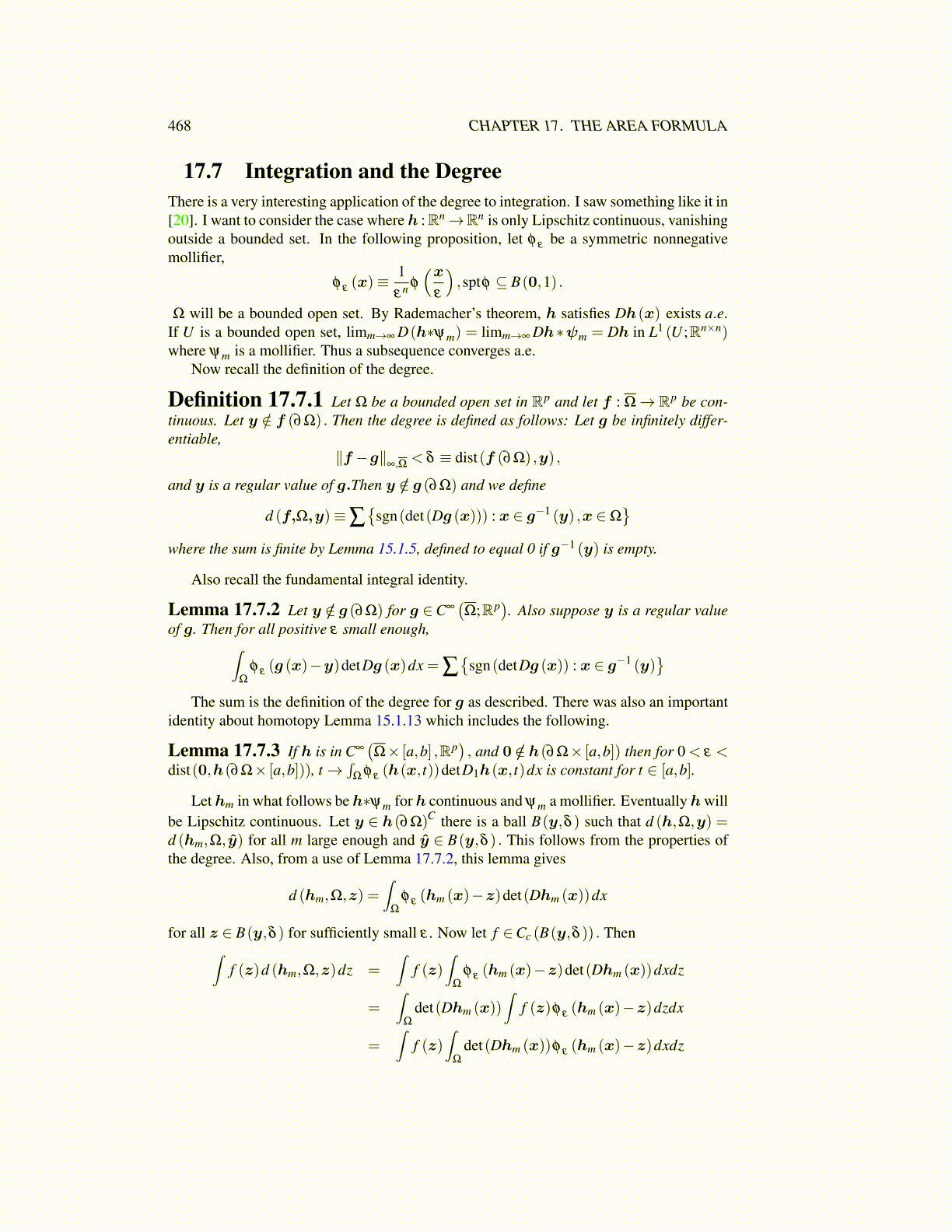
468 CHAPTER 17. THE AREA FORMULA
17.7 Integration and the DegreeThere is a very interesting application of the degree to integration. I saw something like it in[20]. I want to consider the case where h :Rn→Rn is only Lipschitz continuous, vanishingoutside a bounded set. In the following proposition, let φ ε be a symmetric nonnegativemollifier,
φ ε (x)≡1εn φ
(xε
),sptφ ⊆ B(0,1) .
Ω will be a bounded open set. By Rademacher’s theorem, h satisfies Dh(x) exists a.e.If U is a bounded open set, limm→∞ D(h∗ψm) = limm→∞ Dh∗ψm = Dh in L1 (U ;Rn×n)where ψm is a mollifier. Thus a subsequence converges a.e.
Now recall the definition of the degree.
Definition 17.7.1 Let Ω be a bounded open set in Rp and let f : Ω→ Rp be con-tinuous. Let y /∈ f (∂Ω) . Then the degree is defined as follows: Let g be infinitely differ-entiable,
∥f −g∥∞,Ω < δ ≡ dist(f (∂Ω) ,y) ,
and y is a regular value of g.Then y /∈ g (∂Ω) and we define
d (f,Ω,y)≡∑{
sgn(det(Dg (x))) : x ∈ g−1 (y) ,x ∈Ω}
where the sum is finite by Lemma 15.1.5, defined to equal 0 if g−1 (y) is empty.
Also recall the fundamental integral identity.
Lemma 17.7.2 Let y /∈ g (∂Ω) for g ∈C∞(Ω;Rp
). Also suppose y is a regular value
of g. Then for all positive ε small enough,∫Ω
φ ε (g (x)−y)detDg (x)dx = ∑{
sgn(detDg (x)) : x ∈ g−1 (y)}
The sum is the definition of the degree for g as described. There was also an importantidentity about homotopy Lemma 15.1.13 which includes the following.
Lemma 17.7.3 If h is in C∞(Ω× [a,b] ,Rp
), and 0 /∈ h(∂Ω× [a,b]) then for 0 < ε <
dist(0,h(∂Ω× [a,b])), t→∫
Ωφ ε (h(x, t))detD1h(x, t)dx is constant for t ∈ [a,b].
Lethm in what follows beh∗ψm forh continuous and ψm a mollifier. Eventuallyhwillbe Lipschitz continuous. Let y ∈ h(∂Ω)C there is a ball B(y,δ ) such that d (h,Ω,y) =d (hm,Ω, ŷ) for all m large enough and ŷ ∈ B(y,δ ) . This follows from the properties ofthe degree. Also, from a use of Lemma 17.7.2, this lemma gives
d (hm,Ω,z) =∫
Ω
φ ε (hm (x)−z)det(Dhm (x))dx
for all z ∈ B(y,δ ) for sufficiently small ε . Now let f ∈Cc (B(y,δ )) . Then∫f (z)d (hm,Ω,z)dz =
∫f (z)
∫Ω
φ ε (hm (x)−z)det(Dhm (x))dxdz
=∫
Ω
det(Dhm (x))∫
f (z)φ ε (hm (x)−z)dzdx
=∫
f (z)∫
Ω
det(Dhm (x))φ ε (hm (x)−z)dxdz